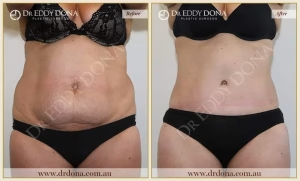Tummy Tuck (Abdominoplasty) Sydney

DR EDDY DONA
Plastic & Reconstructive Surgeon
DR EDDY DONA
Plastic & Reconstructive Surgeon
As a meticulous practitioner, Dr Dona consistently refines his surgical skills, maintaining a steadfast commitment to delivering excellence in Plastic Surgery.
Request a callback and one of our friendly staff will give you a call and discuss the procedure with you

What is a Tummy Tuck (Abdominoplasty)?
Tummy Tuck, also referred to as Abdominoplasty, is a surgery performed to address concerns that relate to the belly following trauma, pregnancy and/or weight loss. The most common concerns are stretch marks (scars caused by skin that has been forced to stretch too much too quickly), excess skin, excess fatty tissue and weakened separated muscles. Other problems can include hernias involving the belly button and significant abdominal wall muscle separation that can affect posture and result in lower back pain. In addition, individuals can express concerns regarding their pubic area which includes fullness and ptosis (droop). This typically causes difficulties with tight fitting clothing and hygiene problems.
These concerns can be addressed with a well-planned Tummy Tuck (Abdominoplasty). The excess skin can be removed including most, if not all, of the lower abdominal wall stretch marks. Doing this means removing many of the stretch mark scars that you can’t hide, and creating a single scar below your bikiki line that can be comfortably hidden. If required (and it usually is), the pubic area is thinned out and lifted.
Also, any muscle separation (along with any hernias) is also repaired. This is a vital part of most Tummy Tucks and provides significant functional benefits. Ultimately the purpose of a Tummy Tuck (Abdominoplasty) is to primarily change function (medical/lifestyle issues) and secondarily change form (appearance).
Tummy Tuck (Abdominoplasty) GALLERY
The displayed before and after pictures are provided as an educational tool to demonstrate some of the results achievable from plastic surgery. All surgeries on this page are performed by Dr Eddy Dona and are published with the written consent by the patients







